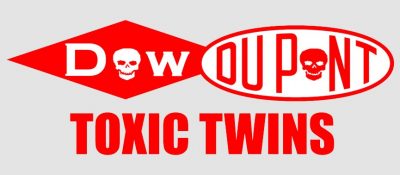
Six of the world’s largest chemical companies are about to merge and create three new mega-corporations. They will control much of the world’s food supply, promoting sterile crops grown in a barren landscape, soaked in dangerous pesticides.
Dow Chemical will merge with DuPont to create one of these new chemical juggernauts later this summer. The EU granted conditional approval to the merger back in March, after an anti-trust investigation, and now the US Department of Justice also says it will permit the merger to proceed. DuPont must agree to divest certain parts of its crop protection portfolio, and Dow divest its global ethylene acrylic acid copolymers and ionomers business
But, this is all despite concerns being raised over apparent attempts, by both companies, to conceal vast liabilities connected with their respective contamination legacies.
After announcing the merger, both companies withheld critical information from shareholders regarding Bhopal liabilities pending against Dow subsidiary Union Carbide. But, unresolved claims in the forthcoming ‘curative’ civil petition alone, aiming to address inadequacies within the 1989 civil settlement, amount to several billion dollars over Carbide’s total book value. In addition, the outstanding criminal manslaughter case has the potential for fines and penalties with no upper limit and Dow has been summoned on five occasions to explain why Union Carbide has never attended court to face the charges.
In the case of DuPont, C8 (or PFOA), a toxin used in the manufacture of Teflon remains a major issue despite DuPont recently making a $670.7 million offer to settle C8 lawsuits connected with contamination emanating from its Washington Works plant in West Virginia. This settlement, if agreed, would include three cases previously tried in a federal court which each received awards running in to the millions of dollars. This makes the $670m proposed settlement look an extremely paltry amount given the 3,500 cases in the class action seeking damages.
Elsewhere, there are known to be serious issues with C-8 contamination around the US, as well as in the Netherlands, Korea, Australia and other countries. In fact, C8 contaminates every continent and country on the globe, and has been detected in the Pacific Ocean and other bodies of water, where the largest concentrations are in the top surface levels.
Worse still, recently emerging stories suggest that, once DuPont finished using C-8, it moved on to another toxic chemical, known as GenX, and continued dumping it in rivers: CLICK Little data exists on the health effects of GenX, but scientists who have reviewed the few studies available say it may pose many of the same risks as C8: CLICK
After the Dow Dupont merger, the new company will be split into three and there is real concern as to where the Bhopal and C8 liabilities will lie. In so far as Dow and Bhopal is concerned, Dow has contrived to maintain a corporate veil between itself and Union Carbide as its chief protection from Carbide’s liabilities- although even that has come into question after the Chief Judicial Magistrate in Bhopal summonsed Dow Directly. But, there has been no statement from Dow as to what form Union Carbide may take, nor where it may sit among the three new entities, and this would only seem to suggest further complication before Union Carbide is ever held to account for its actions.
BMA letter to EU competition commissioner outlines apparent attempts by both companies to evade liabilities: CLICK
Further detail on Dow’s Bhopal liabilities and DuPont’s C8 liabilities: CLICK


